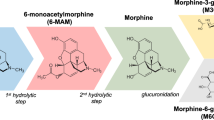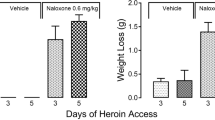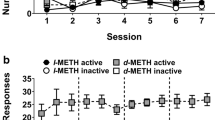Abstract
Rationale
Heroin is rapidly metabolized to morphine that in turn is transformed in morphine-3-glucuronide (M3G), an inactive metabolite, and morphine-6-glucuronide (M6G), a potent mu-opioid receptor (MOR) agonist. We have found that heroin addicts exhibit higher M6G/M3G ratios relative to morphine-treated control subjects. We have also shown that heroin-treated rats exhibit measurable levels of M6G (which is usually undetectable in this species) and reduced levels of M3G.
Objective
We investigated the role of MOR in these effects of heroin, by examining the effects of methadone, a MOR agonist, and of naltrexone, a MOR antagonist, on morphine glucuronidation. We also investigated the effects of alcohol, which is known to alter drug metabolism and is frequently coabused by heroin addicts.
Methods
Morphine glucuronidation was studied in liver microsomes obtained from rats exposed daily for 10 days to saline, heroin (10 mg/kg, i.p.), naltrexone (20–40 mg/kg, i.p.), heroin + naltrexone (10 mg/kg+20–40 mg/kg, i.p.), methadone (5–20 mg/kg, i.p.), or 10% ethanol.
Results
Heroin induced the synthesis of M6G and decreased the synthesis of M3G. Naltrexone exhibited intrinsic modulatory activity on morphine glucuronidation, increasing the synthesis of M3G via a low-affinity/high-capacity reaction characterized by positive cooperativity. The rate of M3G synthesis in the heroin + naltrexone groups was not different from that of the naltrexone groups. Methadone and ethanol induced a modest increase in M3G synthesis and had no effect on M6G synthesis.
Conclusion
The effects of heroin on morphine glucuronidation are not shared by methadone or alcohol (two drugs that figure prominently in the natural history of heroin addiction) and do not appear to depend on the activation of MOR.



Similar content being viewed by others
References
Antonilli L, Semeraro F, Suriano C, Signore L, Nencini P (2003a) High levels of morphine-6-glucuronide in street heroin addicts. Psychopharmacology (Berl) 170:200–204
Antonilli L, Suriano C, Paolone G, Badiani A, Nencini P (2003b) Repeated exposures to heroin and/or cadmium alter the rate of formation of morphine glucuronides in the rat. J Pharmacol Exp Ther 307:651–660
Bayes M, Rabasseda X, Prous JR (2004) Gateways to clinical trials. Methods Find Exp Clin Pharmacol 26:53–84
Bhargava HN, Rahmani NH, Villar VM, Larsen AK (1993) Effects of naltrexone on pharmacodynamics and pharmacokinetics of intravenously administered morphine in the rat. Pharmacology 46:66–74
Christrup LL (1997) Morphine metabolites. Acta Anaesthesiol Scand 41:116–122
Franklin MR, Slawson MH, Moody DE (1993) Selective induction of rat liver phase II enzymes by N-heterocycle analogues of phenanthrene: a response exhibiting high correlation between UDP-glucuronosyltransferase and microsomal epoxide hydrolase activities. Xenobiotica 23:267–277
Fugelstad A, Ahlner J, Brandt L, Ceder G, Eksborg S, Rajs J, Beck O (2003) Use of morphine and 6-monoacetylmorphine in blood for the evaluation of possible risk factors for sudden death in 192 heroin users. Addiction 98:463–470
Infante F, Dominguez E, Trujillo D, Luna A (1999) Metal contamination in illicit samples of heroin. J Forensic Sci 44:110–113
Klepstad P, Kaasa S, Borchgrevink PC (2000) Start of oral morphine to cancer patients: effective serum morphine concentrations and contribution from morphine-6-glucuronide to the analgesia produced by morphine. Eur J Clin Pharmacol 55:713–719
Klotz U, Ammon E (1998) Clinical and toxicological consequences of the inductive potential of ethanol. Eur J Clin Pharmacol 54:7–12
Lotsch J, Geisslinger G (2001) Morphine-6-glucuronide: an analgesic of the future? Clin Pharmacokinet 40:485–499
Lotsch J, Zimmermann M, Darimont J, Marx C, Dudziak R, Skarke C, Geisslinger G (2002) Does the A118G polymorphism at the mu-opioid receptor gene protect against morphine-6-glucuronide toxicity? Anesthesiology 97:814–819
Meineke I, Freudenthaler S, Hofmann U, Schaeffeler E, Mikus G, Schwab M, Prange HW, Gleiter CH, Brockmoller J (2002) Pharmacokinetic modelling of morphine, morphine-3-glucuronide and morphine-6-glucuronide in plasma and cerebrospinal fluid of neurosurgical patients after short-term infusion of morphine. Br J Clin Pharmacol 54:592–603
Milne RW, Nation RL, Somogyi AA (1996) The disposition of morphine and its 3 and 6-glucuronide metabolites in humans and animals, and the importance of the metabolites to the pharmacological effects of morphine. Drug Metab Rev 28:345–472
Narayan SS, Hayton WL, Yost GS (1991) Chronic ethanol consumption causes increased glucuronidation of morphine in rabbits. Xenobiotica 21:515–524
Pauli-Magnus C, Hofmann U, Mikus G, Kuhlmann U, Mettang T (1999) Pharmacokinetics of morphine and its glucuronides following intravenous administration of morphine in patients undergoing continuous ambulatory peritoneal dialysis. Nephrol Dial Transplant 14:903–909
Penson RT, Joel SP, Bakhshi K, Clark SJ, Langford RM, Slevin ML (2000) Randomized placebo-controlled trial of the activity of the morphine glucuronides. Clin Pharmacol Ther 68:667–676
Peterson GM, Randall CT, Paterson J (1990) Plasma levels of morphine and morphine glucuronides in the treatment of cancer pain: relationship to renal function and route of administration. Eur J Clin Pharmacol 38:121–124
Romberg R, Olofsen E, Sarton E, den Hartigh J, Taschner PE, Dahan A (2004) Pharmacokinetic-pharmacodynamic modeling of morphine-6-glucuronide-induced analgesia in healthy volunteers: absence of sex differences. Anesthesiology 100:120–133
Schwartz EL, Brechbuhl AB, Kahl P, Miller MA, Selwyn PA, Friedland GH (1992) Pharmacokinetic interactions of zidovudine and methadone in intravenous drug-using patients with HIV infection. J Acquir Immune Defic Syndr 5:619–626
Skarke C, Darimont J, Schmidt H, Geisslinger G, Lotsch J (2003) Analgesic effects of morphine and morphine-6-glucuronide in a transcutaneous electrical pain model in healthy volunteers. Clin Pharmacol Ther 73:107–121
Trapnell CB, Klecker RW, Jamis-Dow C, Collins JM (1998) Glucuronidation of 3′-azido-3′-deoxythymidine (zidovudine) by human liver microsomes: relevance to clinical pharmacokinetic interactions with atovaquone, fluconazole, methadone, and valproic acid. Antimicrob Agents Chemother 42:1592–1596
Ulens C, Baker L, Ratka A, Waumans D, Tytgat J (2001) Morphine-6beta-glucuronide and morphine-3-glucuronide, opioid receptor agonists with different potencies. Biochem Pharmacol 62:1273–1282
von Euler M, Villen T, Svensson JO, Stahle L (2003) Interpretation of the presence of 6-monoacetylmorphine in the absence of morphine-3-glucuronide in urine samples: evidence of heroin abuse. Ther Drug Monit 25:645–648
Wielbo D, Bhat R, Chari G, Vidyasagar D, Tebbett IR, Gulati A (1993) High-performance liquid chromatographic determination of morphine and its metabolites in plasma using diode-array detection. J Chromatogr 615:164–168
Acknowledgements
This study has been supported by grants from the University of Rome La Sapienza (Finanziamento progetti di ricerca Ateneo) and from the Ministero dell'Istruzione, Università e Ricerca (PRIN-2004052391_001).
Author information
Authors and Affiliations
Corresponding author
Rights and permissions
About this article
Cite this article
Antonilli, L., Petecchia, E., Caprioli, D. et al. Effect of repeated administrations of heroin, naltrexone, methadone, and alcohol on morphine glucuronidation in the rat. Psychopharmacology 182, 58–64 (2005). https://doi.org/10.1007/s00213-005-0030-7
Received:
Accepted:
Published:
Issue Date:
DOI: https://doi.org/10.1007/s00213-005-0030-7




